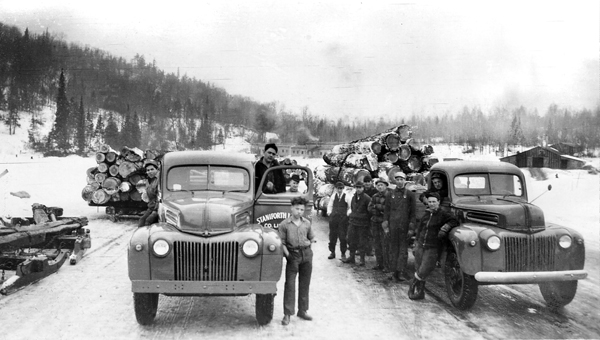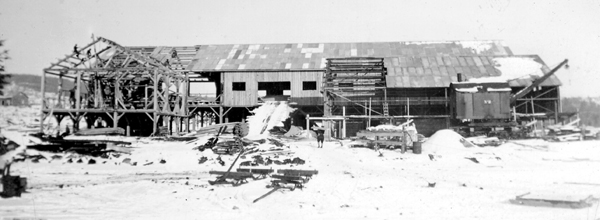 |
July 27, 2001
Staniforth Lumber Company comes to Kiosk
|
 |
|
| Trucks replaced the horses, tractors and train used in Fossmill. |
|
In previous columns I looked at squared timber man William Mackey, prior
to the turn of the century, and J.R. Booth in the early decades of the
1900s in Algonquin Park. Booth's operation was mothballed when no longer
profitable, waiting for an opportunity to come alive.
When the Fossmill mill burned in August 1934 in the middle of the Depression,
dozens of men at the mill and in the bush were put out of work. The bush
workers were primarily farmers from Quebec and Fossmill and many returned
to their roots. Some families from the village of Fossmill left right away
and some tried to find work in the area, but most went on relief-building
roads or the like-for a pittance. Sydney Staniforth, who was a leader at
Fassett, Quebec and Managing Director at Fossmill, went to the United States
to a management position in a mill there. He could not get the former owners
of Fossmill to re-build.
Sydney had a working relationship with J.R. Booth, going back to the
days when Booth gave him a sweetheart deal on the Fossmill limits. Sydney
was close to Booth's heirs-Gertrude, Jackson and Fred Booth-and in 1936
got an agreement from them to give him another deal for the limits around
Kiosk where Booth had his depot for years and where several buildings remained.
Staniforth was primarily interested in the previously unharvested hardwoods.
Sydney found some new investors and formed the Staniforth Lumber Company
and soon had a temporary circular saw set up to cut timber for a full-scale
band saw mill. His carpenters also refurbished the office, cookery, bunkhouse
and warehouses. Men on relief at Fossmill were brought into senior positions
at Kiosk and many other Fossmill men were hired. The men worked six days
a week and caught the Saturday night train or walked 23 km to Fossmill,
where most of the families remained. They were back to work bright and
early on Monday morning.
 |
|
| The Staniforth Lumber Company mill being built at Kiosk in 1936. |
|
Alton Douglas, the first manager at Kiosk, built the first house there
and moved in with his family. Tom Howard, the manager at Fossmill, and
Jack McGibbon, the Bush Manager, contributed to the development of the
operation. When Douglas moved on, Mike Larochelle became manager for 17
years, and was followed by Otto Koch. The Laferrieres bought the Coristine
section house and moved in, as indicated previously, and other houses started
to be built, mostly on a makeshift basis. The company eventually built
more houses, a school, church and recreation facility, etc. Hydro and telephone
soon followed. As Kiosk grew, Fossmill slowly died, with some of the houses
being rented by local people, until eventually all the buildings were torn
down. Nothing remains today but some overgrown roads and some holes in
the ground.
By the late 1940s, Sydney Staniforth's sons Harold, Donald and Robert,
who were well educated and capable, entered the company management. Harold
eventually took over as managing director. Sydney died in 1958 as the result
of a car accident, after 50 years of outstanding leadership in Fassett,
Quebec, Fossmill and Kiosk.
The sons all had pilot's licences and used the company planes for business
and pleasure. Donald oversaw the building of the road from Kiosk to Highway
17, and later established the veneer mill, which kept the company prosperous
and where many women were hired.
In the early 1950s, the International Woodworkers of America Union came
to Kiosk and created some significant improvements; two strikes led to
improved wages and working conditions, consistent with the industry. Romeo
Renaud, one of the union leaders, went on to a long career in the union
movement.
Kiosk at its peak grew to 80 houses and had some 600 residents and a
real sense of community, with extensive recreational activity, winter and
summer, and a lot of camaraderie amongst the families. The original one-room
school was replaced by a three-room school, and several stores were established.
Many of the men worked in the bush as well during the cutting season,
as Staniforth moved from Camp 1, their base camp, to Camp 25 over the 37-year
existence of the operation.
Kiosk reflected the changes in the industry as drying kilns, chainsaws,
skidders and other forest equipment were incorporated. The veneer business
became an increasingly important part of the operation. The CNR continued
to be an important part of the operation as lumber and veneer were shipped
regularly on the new diesel driven trains. Many park residents, tourists
and sportsmen used the train regularly; but it was not to last. Next week
I will look at the demise of the Staniforth operation, and the struggle
of the people to move on to other operations, as the new Algonquin Park
Master Plan left no place for Kiosk in Algonquin Park.
Heritage Perspective Home Page
|

![]() Past
Forward is now on Facebook "LIKE" us to keep in touch
Past
Forward is now on Facebook "LIKE" us to keep in touch